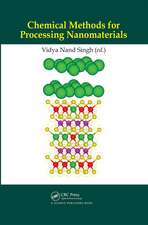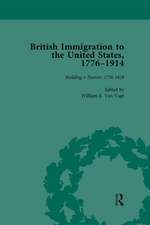Micro and Nano Techniques for the Handling of Biological Samples
Autor Jaime Castillo-León, Winnie Edith Svendsen, Maria Dimakien Limba Engleză Paperback – 14 noi 2018
Micro and Nano Techniques for the Handling of Biological Samples reviews the different techniques available to manipulate and integrate biological materials in a controlled manner, either by sliding them along a surface (2-D manipulation), or by gripping and moving them to a new position (3-D manipulation). The advantages and drawbacks are mentioned together with examples that reflect the state-of-the-art in manipulation techniques for biological samples.
Thanks to the advances in micro- and nanomanipulation techniques, the integration of biomaterials with physical transducers has been possible, giving rise to new and highly sensitive biosensing devices. Although great progress has been made, challenges are still present. To understand the complex interactions between and inside biological samples, scientists will always be working on improving technologies to manipulate, transport, sort, and integrate samples in different environments. Balanced between simplicity for the beginner and hardcore theory for the more advanced readers, this book is the ideal launching point for sharpening the scientific tools required to address these challenges.
Preț: 352.95 lei
Preț vechi: 454.60 lei
-22% Nou
Puncte Express: 529
Preț estimativ în valută:
67.54€ • 73.34$ • 56.74£
67.54€ • 73.34$ • 56.74£
Carte tipărită la comandă
Livrare economică 22 aprilie-06 mai
Preluare comenzi: 021 569.72.76
Specificații
ISBN-13: 9781138381995
ISBN-10: 1138381993
Pagini: 255
Ilustrații: 108
Dimensiuni: 156 x 234 mm
Greutate: 0.45 kg
Ediția:1
Editura: CRC Press
Colecția CRC Press
Locul publicării:Boca Raton, United States
ISBN-10: 1138381993
Pagini: 255
Ilustrații: 108
Dimensiuni: 156 x 234 mm
Greutate: 0.45 kg
Ediția:1
Editura: CRC Press
Colecția CRC Press
Locul publicării:Boca Raton, United States
Cuprins
Interfacing Biological Material with Micro- and Nanodevices. Atomic Force Microscopy for Liquid Applications. Manipulation by Electrical Fields. Optical Manipulation Techniques. Ultrasonic Manipulation Techniques. 3D Biomanipulation Using Microgrippers. Magnetic Manipulation of Biological Structures. Microfluidic Manipulation of Biological Samples.
Notă biografică
Jaime Castillo-León was born in Bucaramanga, Colombia, in 1973. He graduated from the Industrial University of Santander (Bucaramanga, Colombia) with a BSc in Chemistry. He received his PhD degree in 2005 at the Department of Biotechnology, Lund University, Sweden. His PhD work involved the fabrication of electrochemical biosensors for detection of compounds of biomedical importance using cellular models. In 2006 he worked as Postdoc at the Analytical Chemistry Department at Bochum University (Germany) in the development of amperometric biosensors for biomedical applications. He currently holds a position as Assistant Professor within the Nano-Bio integrated Systems group (NaBIS) at the Department of Micro and Nanotechnology, DTU Nanotech, Technical University of Denmark. His research focuses on micro and nanotechnologies for the development of biosensing devices for biomedical applications. A strong focus is currently set on manipulation, characterization and integration of biological self-assembled nanostructures with micro and nano devices for the development of bioelectronic sensing platforms and drug delivery systems.
Maria Dimaki was born in Athens, Greece, in 1978. She graduated amongst the top 2% of her year with an M.Eng. from the Department of Electrical and Computer Engineering at the National Technical University of Athens in 2000 and first in her year with distinction with an M.Sc. degree in Engineering and Physical Science in Medicine in 2001 from the department of Bioengineering at Imperial College London, England. Maria then joined the Department of Micro- and Nanotechnology at the Technical University of Denmark, where she received her PhD degree in 2005 after having worked with the assembly of carbon nanotube devices using dielectrophoresis. Maria has remained with the department since then and she is currently an Associate Professor within the Nano-Bio Integrated Systems group (NaBIS). Maria’s research interests mainly involve the development of micro- and nanoelectrodes in microfluidic systems for electrophysiological and electrochemical measurements on neuron cultures by use of standard microfabrication processes. However, due to her expertise and interest in the matter, Maria is also involved in theoretical simulations of dielectrophoresis on biological particles using COMSOL Multiphysics and Matlab.
Winnie Svendsen was born in Copenhagen, Denmark in 1966. She received her B.Sc degree in 1992 and M.Sc. degree in physics in 1993 from the University College Dublin, Ireland; here she received the EOLAS applied research award for excellent research. Her Ph.D. was from Copenhagen University and RISØ and was finalized in 1996. In 1996 she accepted a postdoctoral position at the Max Planck Institute for Plasma physics. In 1998 Winnie received a talent stipend form SNF (now FNU) and the prestigious Curie stipend from Copenhagen University to establish a research group to design a hyperpolarized gas set-up for use in medical lung diagnostic. In connection to this project Winnie received funding from the European 5th framework to organize a workshop on hyperpolarized gasses. In 1999 she was appointed associate professor at Copenhagen University. She was the co-founder of a company XeHe Hypol (APS). Since 2000 Winnie has been employed as associated professor at DTU. In 2006 she established her own research group Nano Bio Integrated Systems (NaBIS).
Maria Dimaki was born in Athens, Greece, in 1978. She graduated amongst the top 2% of her year with an M.Eng. from the Department of Electrical and Computer Engineering at the National Technical University of Athens in 2000 and first in her year with distinction with an M.Sc. degree in Engineering and Physical Science in Medicine in 2001 from the department of Bioengineering at Imperial College London, England. Maria then joined the Department of Micro- and Nanotechnology at the Technical University of Denmark, where she received her PhD degree in 2005 after having worked with the assembly of carbon nanotube devices using dielectrophoresis. Maria has remained with the department since then and she is currently an Associate Professor within the Nano-Bio Integrated Systems group (NaBIS). Maria’s research interests mainly involve the development of micro- and nanoelectrodes in microfluidic systems for electrophysiological and electrochemical measurements on neuron cultures by use of standard microfabrication processes. However, due to her expertise and interest in the matter, Maria is also involved in theoretical simulations of dielectrophoresis on biological particles using COMSOL Multiphysics and Matlab.
Winnie Svendsen was born in Copenhagen, Denmark in 1966. She received her B.Sc degree in 1992 and M.Sc. degree in physics in 1993 from the University College Dublin, Ireland; here she received the EOLAS applied research award for excellent research. Her Ph.D. was from Copenhagen University and RISØ and was finalized in 1996. In 1996 she accepted a postdoctoral position at the Max Planck Institute for Plasma physics. In 1998 Winnie received a talent stipend form SNF (now FNU) and the prestigious Curie stipend from Copenhagen University to establish a research group to design a hyperpolarized gas set-up for use in medical lung diagnostic. In connection to this project Winnie received funding from the European 5th framework to organize a workshop on hyperpolarized gasses. In 1999 she was appointed associate professor at Copenhagen University. She was the co-founder of a company XeHe Hypol (APS). Since 2000 Winnie has been employed as associated professor at DTU. In 2006 she established her own research group Nano Bio Integrated Systems (NaBIS).
Recenzii
"Written as a multi-authored text by pioneers and specialists in their respective research fields, this timely monograph is not only an exhaustive and updated compilation of bibliography related to micro and nano techniques in use for efficient manipulation and integration of biological materials, but also a practical guide for all those interested in their direct application to practical studies. This book is an ideal text for academics, physicians and scientists working in this interesting and promising research area, but is also suitable for newcomers trying to obtain a general but complete overview of the subject."
—Chromatographia, (2013) 76:299–300
—Chromatographia, (2013) 76:299–300
Descriere
The techniques and tools used to understand many biological problems must be able to handle biological material without damaging or altering its natural state. This book assesses various micro and nano techniques currently available to handle these materials. It shows how the techniques can effectively manipulate biological samples, and highlights the advantages and shortcomings of each. The authors also help readers understand how the manipulation tools work and how to determine the appropriate tool for their needs.




















![Chemical Thermodynamics for Metals and Materials (with CD-ROM for Computer-Aided Learning) [With CDROM]](https://i2.books-express.ro/bt/9781860941771/chemical-thermodynamics-for-metals-and-materials-with-cd-rom-for-computer-aided-learning-with-cdrom.jpg)
